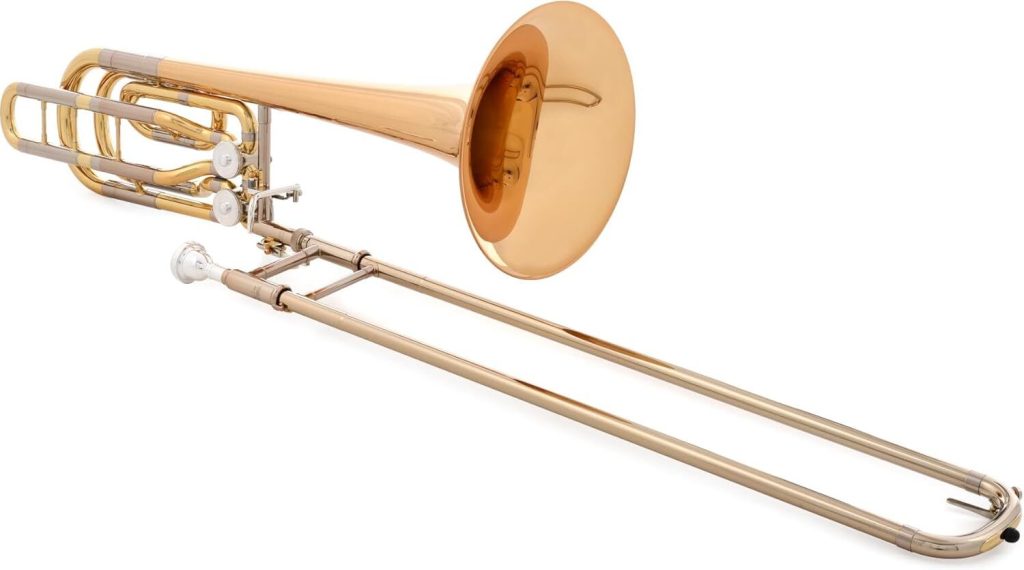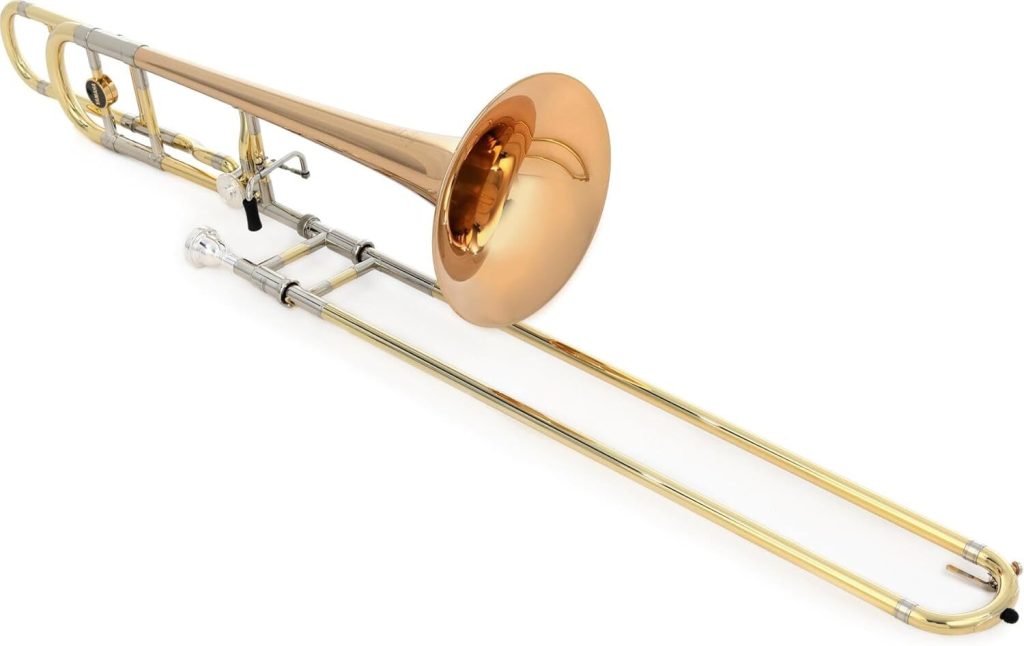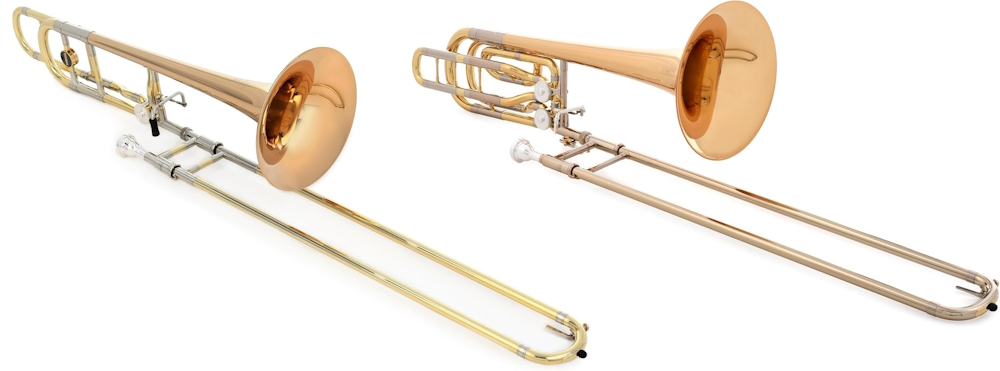This article contains affiliate links. Learn more.
The trombone family offers a remarkable range of tonal colors and expressive capabilities within the brass section. Among its members, the tenor and bass trombones stand as the most widely used variants, each bringing distinct characteristics to ensembles ranging from symphony orchestras to jazz bands, wind ensembles, and brass quintets.
While appearing similar at first glance, these instruments differ significantly in design, sound production, repertoire, and playing technique. Understanding these differences helps musicians, educators, conductors, and even listeners appreciate the unique role each instrument plays in musical settings.
Example of a Bass Trombone

Shown above: Yamaha YBL-620G Bass Trombone
Example of a Tenor Trombone

Shown above: Yamaha YSL-882IIGO
This article explores the key distinctions between bass and tenor trombones, examining their physical characteristics, sound qualities, typical applications, and the specific demands they place on performers. Whether you’re a student deciding which trombone path to pursue, an educator guiding young musicians, or simply a music enthusiast seeking to deepen your understanding, this comparison will illuminate the fascinating world of these versatile brass instruments.
Check out our article over an interesting question – how much do trombones weigh?
Table of Contents
Physical Differences
The most obvious distinctions between tenor and bass trombones are their physical characteristics, which directly influence their sound production and playing experience.
Bore Size
The bore size—the inner diameter of the main cylindrical tubing—represents one of the most significant differences between these instruments:
- Tenor Trombone: Typically features a small to medium bore size (.500″ to .547″), with most standard tenor trombones around .500″ to .525″
- Bass Trombone: Utilizes a larger bore, generally .562″ or greater
This difference in bore size affects the amount of air required, the resistance felt by the player, and the overall tonal character. The larger bass trombone bore allows for greater air volume and contributes significantly to its characteristic robust, powerful low register.
Bell Size and Design
The bell section also differs considerably:
- Tenor Trombone: Usually features a bell diameter between 7.5″ and 8.5″
- Bass Trombone: Typically employs a larger bell diameter of 9.5″ to 10.5″
The bass trombone’s larger bell facilitates better projection in the low register and contributes to its broader, more sonorous tone quality. The bell flare (how quickly the bell expands) also tends to be different, with bass trombones often featuring a more gradual flare to enhance low-frequency resonance.
Valve Systems
Perhaps the most visually distinctive difference is the valve section:
- Tenor Trombone: Often comes as a “straight” instrument with no valves, though professional models frequently include a single F-attachment valve that extends the range downward
- Bass Trombone: Almost always features a dual-valve system (typically F and D or F and Gb configurations) that significantly extends the lower range and provides alternative positions for technical passages
These valve systems affect not only the range but also the instrument’s weight, balance, and handling characteristics.
Mouthpiece
The instruments use distinctly different mouthpieces:
- Tenor Trombone: Utilizes smaller mouthpieces with cup diameters typically ranging from 24.5mm to 27mm
- Bass Trombone: Requires larger mouthpieces with cup diameters of 28mm to 32mm
According to the International Trombone Association, the mouthpiece represents a critical component in achieving the characteristic sound of each instrument, with the larger bass trombone mouthpiece facilitating the production of its distinctive rich, deep timbre.
Weight and Materials
Overall weight and construction materials can also differ:
- Tenor Trombone: Generally lighter, often constructed from yellow brass with occasional components in gold brass or silver
- Bass Trombone: Significantly heavier due to larger dimensions and additional valve systems, often utilizing thicker brass for enhanced projection and durability
Tonal Characteristics
The physical differences between these instruments translate directly into distinctive tonal qualities that define their musical roles.
Tenor Trombone Sound
The tenor trombone produces a sound that is:
- Brighter and more focused
- Rich in upper harmonics
- Agile and articulate
- Naturally projecting in the middle register
- Versatile across multiple musical styles
Its voice is often described as noble and singing, with a directness that allows it to function equally well as a melodic or harmonic instrument. The tenor trombone’s sound can cut through an ensemble when needed but also blend beautifully with other brass instruments.
Bass Trombone Sound
The bass trombone delivers a sound characterized by:
- Deeper, darker fundamental tones
- Richer low-end resonance
- Powerful projection, especially in the low register
- Broader, more commanding presence
- Foundational quality that anchors brass sections
The bass trombone’s voice has been described as authoritative and profound. While it can certainly perform melodic passages, its natural habitat is often providing the harmonic foundation for brass sections or delivering dramatic low-register statements.
Range and Repertoire
The practical range and typical repertoire for each instrument highlight their specialized roles in various ensembles.
Range Comparison
- Tenor Trombone: Effective range from E2 (below bass clef) to Bb5 (above treble clef), with the most comfortable range between F2 and F5
- Bass Trombone: Effective range from Bb1 (contra-octave Bb) to F5, with exceptional power and clarity in the lower octaves
The bass trombone’s extended lower range, facilitated by its valve system, allows it to serve effectively as a bass voice in brass ensembles. However, the modern bass trombone is also capable of considerable agility throughout its range, challenging the traditional view of it as merely a low-note specialist.
Orchestral Repertoire
In orchestral settings, the roles are generally well-defined:
- Tenor Trombone: Typically plays 1st and 2nd trombone parts, often handling melodic lines, harmonies, and contributing to tutti brass passages
- Bass Trombone: Usually performs the 3rd trombone part, providing the bass foundation for the trombone section and sometimes doubling tuba or contrabassoon lines
Composers from the Romantic era onward have increasingly written specifically for bass trombone, recognizing its unique voice. Works by Wagner, Bruckner, Mahler, and Strauss feature prominent bass trombone parts that showcase the instrument’s distinctive capabilities.
Jazz and Commercial Music
In jazz and commercial settings:
- Tenor Trombone: Frequently handles solo work, melodic lines, and improvisational passages in big bands and smaller ensembles
- Bass Trombone: Often provides the bottom end of section harmonies in big bands, though modern jazz has seen more prominent bass trombone soloing
Influential bass trombonists like George Roberts (known as “Mr. Bass Trombone”) helped establish the instrument as more than just a supporting voice in jazz contexts, demonstrating its potential for lyrical playing and technical facility.
Technical Considerations and Playing Differences
The physical distinctions between these instruments create different technical demands for performers.
Air Requirements
One of the most significant differences lies in breath support and air management:
- Tenor Trombone: Requires less air volume but often demands precise control for delicate passages
- Bass Trombone: Necessitates substantially greater air capacity and support, particularly in the lowest register
Bass trombonists typically develop enhanced breathing techniques to maintain the consistent, powerful airflow needed for their instrument. This difference in air requirement influences everything from warm-up routines to endurance considerations.
Slide Technique
Slide technique also varies between the instruments:
- Tenor Trombone: Generally utilizes all seven slide positions within a relatively compact physical range
- Bass Trombone: Combines slide positions with valve combinations, creating a more complex system of alternate positions that reduces the physical distance the slide must travel
The bass trombone’s valve system essentially creates multiple overlapping sets of positions, allowing players to navigate technical passages with greater efficiency once they master the more complex system of alternate positions.
Articulation Approaches
Articulation techniques differ subtly but importantly:
- Tenor Trombone: Often employs a lighter, more defined articulation style
- Bass Trombone: Typically requires slightly stronger tongue articulation to achieve clarity, particularly in the lower register
These differences reflect the distinct acoustic properties of each instrument, with the larger bore and greater air volume of the bass trombone necessitating adapted techniques for clear articulation.
Choosing Between Bass and Tenor Trombone
For students and educators considering which instrument to pursue or recommend, several factors merit consideration.
Physical Considerations
- Size and Strength: The bass trombone’s additional weight and air requirements may present challenges for younger or smaller players
- Hand Size: The larger slide diameter of the bass trombone may be difficult for players with smaller hands to grip securely
- Endurance: The greater physical demands of the bass trombone can affect playing stamina, particularly for developing players
Musical Interests and Goals
Career aspirations and musical preferences also influence the choice:
- Orchestral Aspirations: Professional orchestras typically employ two tenor trombonists and one bass trombonist, making bass trombone positions more limited but also less competitive
- Jazz Interests: Players primarily interested in improvisation and solo jazz playing might gravitate toward tenor trombone
- Ensemble Preferences: Those who enjoy providing the harmonic foundation might find bass trombone more satisfying
Educational Pathway
Most educators recommend starting on tenor trombone before transitioning to bass trombone if desired. This approach allows players to:
- Develop fundamental technique with the physically less demanding instrument
- Establish good habits of sound production and articulation
- Build the necessary lung capacity and embouchure strength gradually
- Make an informed choice based on direct playing experience
Many successful bass trombonists began their studies on tenor trombone, transitioning after developing a solid technical foundation.
Noteworthy Performers
Examining influential performers on each instrument provides insight into their distinctive capabilities and roles.
Renowned Tenor Trombonists
- Joseph Alessi: Principal trombonist of the New York Philharmonic, known for his remarkable technical facility and expressive playing
- Christian Lindberg: Pioneering soloist who has commissioned hundreds of new works for tenor trombone
- J.J. Johnson: Revolutionary jazz trombonist who adapted bebop’s rapid tempos and complex harmonies to the instrument
Distinguished Bass Trombonists
- Charles Vernon: Bass trombonist of the Chicago Symphony Orchestra, known for his expansive range and powerful sound
- George Roberts: Defined the modern bass trombone sound in studio and jazz settings
- Stefan Schulz: Berlin Philharmonic bass trombonist who has significantly expanded the solo repertoire for the instrument
Maintenance and Care Differences
While both instruments require similar general maintenance, some aspects differ:
- Slide Care: The larger bass trombone slide may require more lubricant and attention to maintain smooth action
- Valve Maintenance: Bass trombone valves need regular oiling and occasional disassembly for cleaning
- Water Drainage: Bass trombones typically accumulate more condensation due to greater air volume, necessitating more frequent emptying
Conclusion
The tenor and bass trombones, while part of the same instrumental family, represent distinct voices with unique characteristics and roles. The tenor trombone’s agility, directness, and versatility contrast with the bass trombone’s power, depth, and foundational qualities, creating complementary voices that enrich countless musical settings.
Understanding these differences helps musicians make informed choices about which instrument to play or purchase, guides educators in advising students, and enhances listeners’ appreciation of the distinct contributions each makes to ensemble sound.
Whether projecting a soaring melody, delivering punchy rhythmic figures, providing harmonic support, or unleashing earth-shaking low notes, these remarkable instruments continue to evolve through the innovations of manufacturers and the creativity of performers, ensuring their vital place in music’s future.
Disclaimer: As an Amazon Associate, I earn from qualifying purchases. All product recommendations are based on research and experience rather than direct testing of every instrument mentioned. Specific prices have been omitted as they vary by retailer and change over time.

